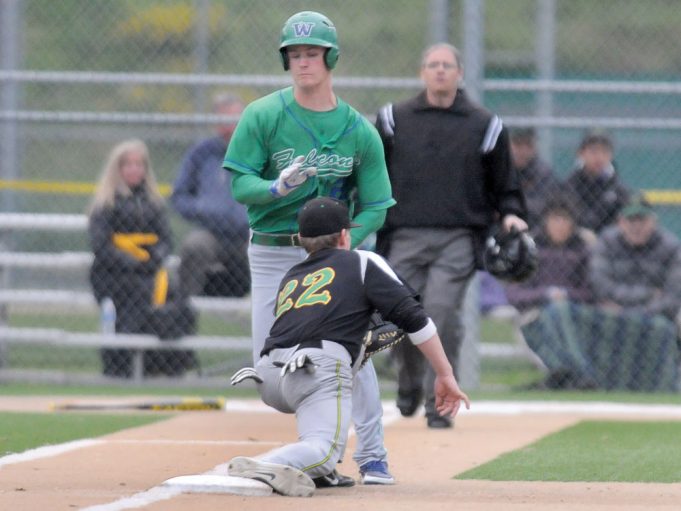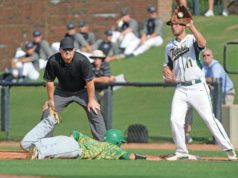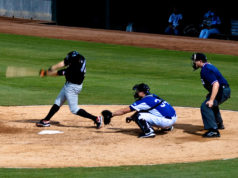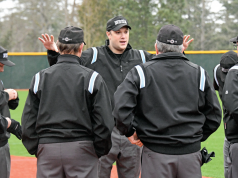In the top of the seventh inning in Game 6 of the World Series on Oct. 29, 2019, the Washington Nationals had Yan Gomes on first and leadoff hitter Trea Turner at the plate with no outs.
Turner hit a slow roller down the third-base line. As he dashed toward first, his path kept him narrowly in fair territory. Houston pitcher Brad Peacock fielded the ball and his throw pulled first baseman Yuli Gurriel toward the baseline. Turner ran into Gurriel’s glove, knocking it off his hand. The ball, meanwhile, bounced off Turner’s leg and into foul territory. Gomes ended up making it to third, and Turner ended up at second.
Plate umpire Sam Holbrook, however, ruled Turner out for running lane interference. Gomes was put back at first base. The video shows Turner ran the last half of the distance from home to first well out of the running lane; however, that is only part of the rule. Let’s take a look at each element of the rule and see what was and was not violated.
The rule is largely the same in all three codes (NFHS 8-4-1g; NCAA 7-11p; pro 5.09a11). As mentioned, under certain conditions the batter-runner is severely restricted as to where he may run. He is required to run the last half of the distance from home to first base within the three-foot lane. The lines are part of the lane, so stepping on the line is not a violation. Also, one foot inside the lane (or on the line) and the other foot in the air is permissible. The batter-runner must take two consecutive steps totally outside the lane to violate the rule.
Another requirement that triggers the rule is the “origin” of the throw. Although that is not specifically addressed in the rules, it is understood the throw must be made from “the area of the plate.” The originating area is not a precise one and it allows umpires to make a distinction between throws that are roughly parallel to the first-base line and those made from the infield dirt or the pitcher’s mound. The restriction applies both to batted balls and uncaught third strikes. It does not apply on throws in the opposite direction. So if the first baseman were to field a batted ball and throw to the plate, it doesn’t matter where the batter-runner is running.
Somewhat surprisingly the rule is not about interference with the throw, but rather about interference with the fielder taking the throw at first base. There must be a throw for this rule to apply; if there is no throw it’s impossible to interfere with a fielder taking a throw. Additionally, if there is no fielder in position at first base to catch the throw, the batter-runner’s position and any contact with the ball is immaterial. The play simply was not going to be completed.
It must also be a quality throw. It is not interference if the throw had no realistic chance of retiring the batter-runner, unless in the umpire’s judgment the bad throw is a direct result of the batter-runner’s improper position (NFHS only). The NFHS rule is designed to avoid the unstated philosophy in NCAA and pro play which is to hit the runner in the back with the throw to erase any doubt in the umpire’s mind.
At some point in time, the batter-runner has to leave the lane. That may be to evade a tag, avoid contact with a fielder or simply to touch first base. How the batter-runner does that is dependent on the throw and the position of the fielder as well as his own position. NCAA rules provide for an exit strategy by means of a step, stride, reach or slide in the immediate vicinity of first base. He may exit the running lane on his last stride or step if he has been running legally within the running lane up to that point (7-11p Nt 1 Exc.). Although not stated in the other codes, it is an excellent guideline to follow.
Third Strike
As noted, the runner’s lane applies on an uncaught third strike. In high school play, the batter-runner on an uncaught third strike doesn’t lose his opportunity to advance until he enters the dugout (NFHS 7-4-1b1, 8-1-1b, 8-4-1f, 8.1.1B). Thus at any time prior, he can advance using any basepath he desires. In NCAA and pro, such a batter who does not recognize his situation is out when he leaves the dirt area surrounding home plate (NCAA 7-11u; pro 5.05a2 Cmt). In all codes, if he does recognize that he may advance, he is not restricted as to the path he may take to first base.
Penalty
The penalty for interference is an immediate dead ball and the batter-runner is out; any other runners return to the base occupied at the time of the pitch except in NFHS, where runners are returned to the base occupied at the time of interference (NFHS 8-4-1g, 8-2-9; NCAA 7-11p; pro 5.09a11). In NCAA and pro, if there is an intervening play (such as a play at the plate) between the batted ball and an act of interference by the batter-runner before he reaches first base, the runners return to the base occupied at the time of the interference (NCAA 2-51 Nt. 2; pro 6.01a Pen. para. 2). That could make the difference in the scoring of a run. Any time a runner who thought he had scored has to be pulled out of the dugout and returned to third, the umpires can expect fireworks.
As the World Series game demonstrated, plays involving the runner’s lane are highly prone to dispute. The ruling led to the ejection of Nationals manager Dave Martinez, the first manager ejected from a World Series game since 1996. The only slam dunk, so to speak, is likely when the batter-runner gets plunked in the back while he is clearly outside the lane.
What's Your Call? Leave a Comment:
Note: This article is archival in nature. Rules, interpretations, mechanics, philosophies and other information may or may not be correct for the current year.
This article is the copyright of ©Referee Enterprises, Inc., and may not be republished in whole or in part online, in print or in any capacity without expressed written permission from Referee. The article is made available for educational use by individuals.


















